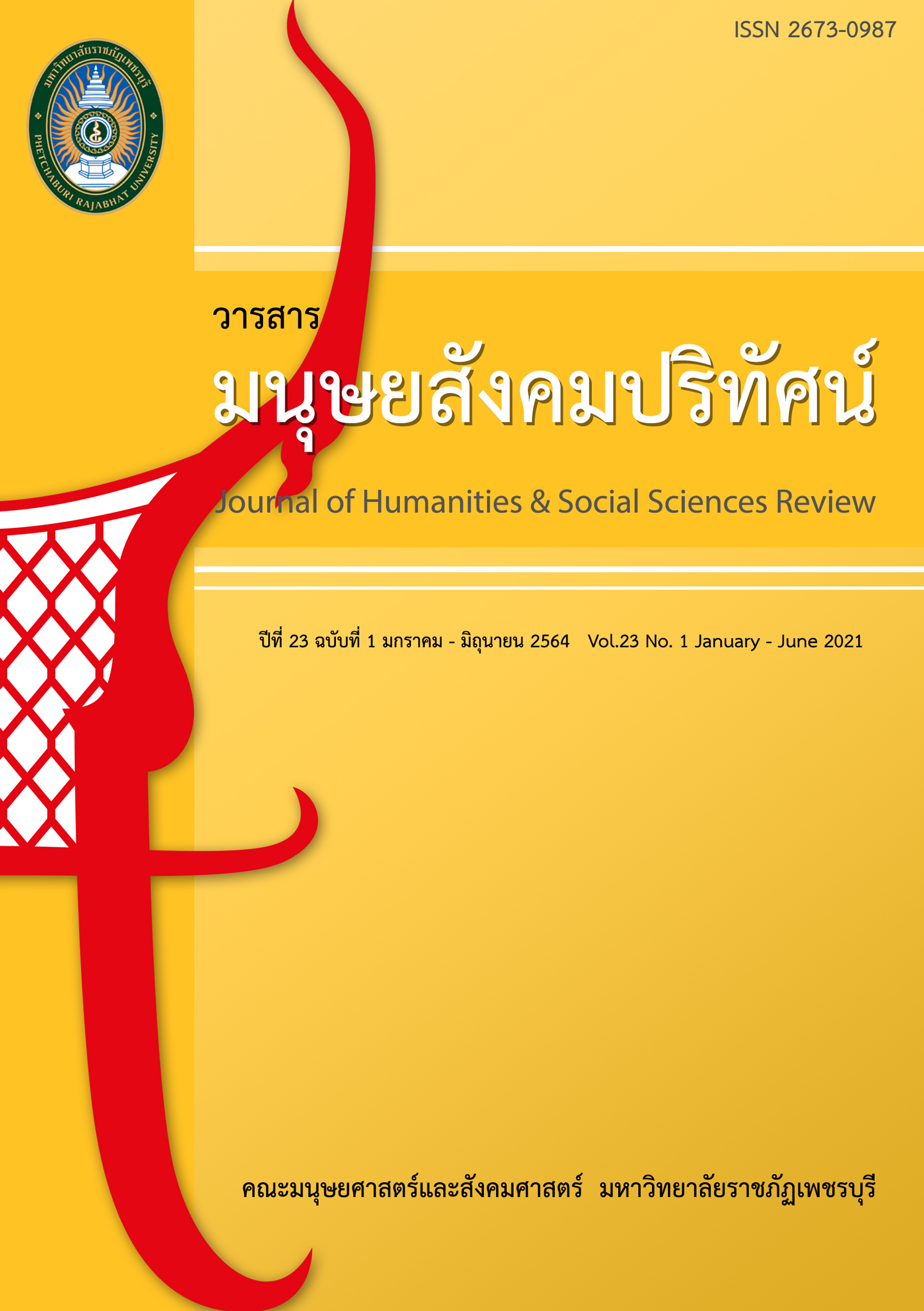แนวทางการพัฒนาทักษะการเรียนรู้ในศตวรรษที่ 21 ของนักเรียนมัธยมศึกษาปีที่ 1 ด้วยนิทานธรรมบท ในโรงเรียนคงคาราม อำเภอเมือง จังหวัดเพชรบุรี
Main Article Content
บทคัดย่อ
การวิจัยครั้งนี้มีวัตถุประสงค์เพื่อ 1) ศึกษาองค์ประกอบสำคัญที่สนับสนุนการพัฒนาผู้เรียนในศตวรรษที่ 21 2) ศึกษาทักษะการเรียนรู้ด้วยนิทานธรรมบท และ 3) เสนอแนวทางการพัฒนาทักษะการเรียนรู้ในศตวรรษที่ 21 ของนักเรียนมัธยมศึกษาปีที่ 1 ด้วยนิทานธรรมบท เป็นการวิจัยแบบผสมผสาน การวิจัยเชิงปริมาณใช้แบบสอบถามกับนักเรียนมัธยมศึกษาปีที่ 1 โรงเรียนคงคาราม จังหวัดเพชรบุรี กลุ่มตัวอย่างจำนวน 210 คน การสุ่มตัวอย่างแบบแบ่งชั้นภูมิ มีค่าความเชื่อมั่นเท่ากับ 0.92 สถิติที่ใช้ในการวิเคราะห์ข้อมูล ได้แก่ ความถี่ ค่าเฉลี่ย และส่วนเบี่ยงเบนมาตรฐาน การวิจัยเชิงคุณภาพ ใช้แบบสัมภาษณ์เชิงลึกแบบมีโครงสร้างกับผู้ให้ข้อมูลสำคัญ จำนวน 10 คน การเลือกกลุ่มตัวอย่างแบบเจาะจง โดยการพรรณาความ ผลการวิจัยพบว่า 1) องค์ประกอบสำคัญที่สนับสนุนการพัฒนาผู้เรียนในศตวรรษที่ 21 โดยภาพรวมอยู่ในระดับมาก เมื่อพิจารณาเป็นรายด้านข้อที่มีค่าเฉลี่ยมากที่สุดไปหาน้อยสุด คือ ด้านการสร้างเจตคติของผู้เรียนและแรงจูงใจในการเรียนรู้ รองลงมาด้านทักษะชีวิตและอาชีพ และด้านการใช้เทคโนโลยีได้อย่างสร้างสรรค์และมีประสิทธิภาพ 2) ทักษะการเรียนรู้ด้วยนิทานธรรมบท โดยภาพรวมอยู่ในระดับมาก เมื่อพิจารณาเป็นรายด้านข้อที่มีค่าเฉลี่ยมากที่สุดไปหาน้อยสุด คือ ด้านการถาม (ปุจฉา) รองลงมา ด้านการฟัง (สุตะ) และด้านการจดบันทึก (ลิขิต) 3) แนวทางการพัฒนาทักษะการเรียนรู้ในศตวรรษที่ 21 ของนักเรียนมัธยมศึกษาปีที่ 1 ด้วยนิทานธรรมบท ในโรงเรียนคงคาราม อำเภอเมือง จังหวัดเพชรบุรี ประกอบด้วย 4 ด้าน ได้แก่ 1) ด้านโรงเรียน ควรมียุทธศาสตร์สำหรับการจัดการเรียนรู้ในศตวรรษที่ 21 เพื่อเป็นแนวทางในการจัดการเรียนรู้ 2) ด้านผู้สอน ควรจัดการเรียนรู้ที่มีความหลากหลาย เพื่อสร้างแรงจูงใจในการเรียนรู้ของผู้เรียน 3) ด้านผู้เรียน ควรตระหนักถึงความสำคัญต่อเรื่องที่เรียน เพื่อนำสิ่งที่เรียนรู้ไปประยุกต์ใช้ในชีวิตประจำวัน และ 4) ด้านพระสอนศีลธรรม ควรส่งเสริมผู้เรียนให้มีส่วนร่วม เพื่อพัฒนาทักษะความคิด และการเรียนรู้ด้วยตนเอง
Article Details
1. มุมมองและความคิดเห็นใด ๆ ในบทความเป็นมุมมองของผู้เขียน คณะบรรณาธิการไม่จำเป็นต้องเห็นด้วยกับมุมมองเหล่านั้นและไม่ถือเป็นความรับผิดชอบของคณะบรรณาธิการ ในกรณีที่มีการฟ้องร้องเกี่ยวกับการละเมิดลิขสิทธิ์ ให้ถือเป็นความรับผิดชอบของผู้เขียน แต่เพียงผู้เดียว
2. ลิขสิทธิ์บทความที่เป็นของคณะมนุษยศาสตร์และสังคมศาสตร์ มหาวิทยาลัยราชภัฏเพชรบุรีมีลิขสิทธิ์ถูกต้องตามกฎหมาย การเผยแพร่จะต้องได้รับอนุญาตโดยตรงจากผู้เขียนและมหาวิทยาลัยราชภัฏเพชรบุรีเป็นลายลักษณ์อักษร
เอกสารอ้างอิง
2. ชาย โพธิสิตา. (2554). ศาสตร์และศิลป์แห่งการวิจัยเชิงคุณภาพ (พิมพ์ครั้งที่ 5). กรุงเทพฯ: อมรินทร์พริ้นติ้ง.
3. ชายุดา จันทะปิดตา. (2556). การพัฒนาแบบฝึกเสริมทักษะการฟังภาษาอังกฤษเพื่อการสื่อสาร สำหรับนักเรียนชั้นมัธยมศึกษาชั้นปีที่ 4 โรงเรียนบัวหลวงวิทยาคม จังหวัดบุรีรัมย์. วารสารวิชาการ Veridian E-Journal, 6(2): 197-211.
4. ณิชชา จุนทะเกาศลย์. (2561). นิทานธรรมบท ทางแห่งความดีหลีกความชั่ว. ค้นเมื่อ 30 กันยายน 2561, จาก https://www.phuttha.com/คลังความรู้/บทความวิชาการ/นิทานธรรมบท-ทางแห่งความดีหลีกความชั่ว.
5. ธนสิทธิ์ คณฑา. (2551). การศึกษาการสอนแบบ Active Learning เพื่อพัฒนาคุณธรรมจริยธรรมของนักศึกษา มหาวิทยาลัยราชภัฏนครสวรรค์ ที่ลงเรียนในรายวิชาบัณฑิตอุดมคติไทย. นครสวรรค์: มหาวิทยาลัยราชภัฏนครสวรรค์.
6. ธนารัตน์ มาลัยศรี. (2556). การพัฒนาทักษะการคิดอย่างมีวิจารณญาณของนักเรียนชั้นมัธยมศึกษาปี ที่ 1 ในหน่วยการเรียนรู้แบบย้อนกลับเรื่องประชาคมอาเซียน โดยใช้รูปแบบการสอนแบบสืบเสาะหาความรู้ (5Es). วิทยานิพนธ์ศึกษาศาสตรมหาบัณฑิต สาขาวิชาหลักสูตรและการสอน บัณฑิตวิทยาลัย มหาวิทยาลัยขอนแก่น.
7. ปุณยา จันทมาตย์. (2557). การศึกษาทักษะการสอนของครูสังคมศึกษาเพื่อการเรียนรู้ในศตวรรษที่ 21 ในโรงเรียนมาตรฐานสากลระดับมัธยมศึกษา. OJED, 10(4): 612-624.
8. พวงรัตน์ ชำนาญเลิศกิจ. (2558). ศึกษาการส่งเสริมนักเรียนให้มีคุณธรรมจริยธรรม โรงเรียนประถมศึกษา สำนักงานเขตป้อมปราบศัตรูพ่าย กรุงเทพมหานคร. วิทยานิพนธ์พุทธศาสตรมหาบัณฑิต สาขาวิชาการบริหารการศึกษา บัณฑิตวิทยาลัย มหาวิทยาลัยมหาจุฬาลงกรณราชวิทยาลัย.
9. พิเชษฐ ยังตรง. (2560). กลยุทธ์การพัฒนาคุณลักษณะที่พึงประสงค์ของผู้เรียนในสถานศึกษาขั้นพื้นฐานในศตวรรษที่ 21. วิทยานิพนธ์ศึกษาศาสตรดุษฎีบัณฑิต สาขาวิชาการจัดการศึกษา วิทยาลัยครุศาสตร์ มหาวิทยาลัยธุริจบัณฑิต.
10. วรางคณา เค้าอ้น. (2560). การพัฒนาทักษะการสื่อสารภาษาอังกฤษของนักเรียนชั้นประถมศึกษาปีที่ 4 โดยใช้สถานการณ์เป็นฐานการเรียนรู้. วิทยานิพนธ์ศึกษาศาสตรมหาบัณฑิต สาขาวิชาหลักสูตรและการสอน วิทยาลัยครุศาสตร์ มหาวิทยาลัยธุรกิจบัณฑิตย์.
11. ศศิธร อินตุ่น. (2559). การใช้กิจกรรมจดบันทึกคอร์เนลล์เพื่อส่งเสริมทักษะการเรียน ผลสัมฤทธิ์ทางการเรียนและความคิดเห็นของนักศึกษา สาขาวิชาการประถมศึกษา มหาวิทยาลัยราชภัฏเชียงใหม่. วารสารวิชาการมหาวิทยาลัยฟาร์อีสเทอร์น, 10(1): 108-120.
12. ศุจิกา เพชรล้วน. (2554). การศึกษาผลสัมฤทธิ์ทางการเรียนวิทยาศาสตร์และความสามารถในการคิดอย่างมีวิจารณญาณของนักเรียนชั้นมัธยมศึกษาปีที่ 1 ที่ได้รับการจัดการเรียนรู้แบบสรรค์สร้างความรู้กับการจัดการเรียนรู้แบบใช้ปัญหาเป็นฐาน. ปริญญาการศึกษามหาบัณฑิต สาขาวิชาการมัธยมศึกษา มหาวิทยาลัยศรีนครินทรวิโรฒ.
13. สำนักบริหารงานการมัธยมศึกษาตอนปลาย สพฐ. (2561). แนวทางจัดการเรียนรู้ในศตวรรษที่ 21. ค้นเมื่อ 21 ตุลาคม 2561, จาก https://webs.rmutl.ac.th/assets/upload/files/.pdf
14. สุวิชา ศรีมงคล. (2557). การส่งเสริมทักษะการเรียนรู้ในศตวรรษที่ 21: ทักษะการสื่อสารและความร่วมมือในชั้นเรียนวิทยาศาสตร์ เรื่องเซลล์และองค์ประกอบของเซลล์ด้วยสถานการณ์จำลอง. วิทยานิพนธ์ศึกษาศาสตรมหาบัณฑิต สาขาวิชาหลักสูตรและการสอน บัณฑิตวิทยาลัย มหาวิทยาลัยขอนแก่น.
15. สุวิธิดา จรุงเกียรติกุล. (2561). ทักษะการเรียนรู้ในศตวรรษที่ 21 (The Twenty-First Century Skills). ค้นเมื่อ 3 ตุลาคม 2561, จาก http://www.trueplookpanya.com/blog/content.
16. Austin, A. E., & Baldwin, R. G. (1991). Faculty collaboration: Enhancing the quality of scholarship and teaching. Washington, DC: School of Education and Human Development.
17. Delors, J. (1998). Learning: The treasure within: Report to UNESCO of The International Commission on Education for the 21st Century. Paris: UNESCO.
18. Whitehead, A. N. (1931). Business adrift. New York: McGraw–Hill.


